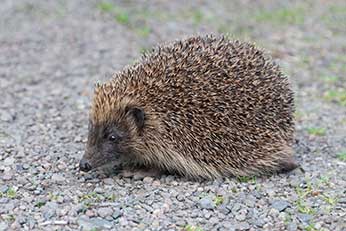New Forest hedgehogs

on the Crown Lands of the New Forest
Hedgehogs are scarce on the Crown Lands of the New Forest. In fact, hedgehogs are rarely seen at all, and there is little evidence to suggest even occasional presence.
And the reasons for this? Well, in the acid New Forest soils, the hedgehog’s favourite foodstuffs – earthworms, slugs and snails – occur only in modest numbers; whilst badgers, significant hedgehog predators, are widespread (although nationally, there does not seem to be a strong link between high badger numbers and low numbers of hedgehogs).
Hedgehogs are, though, found in and around local villages where more neutral soils better support hedgehog foodstuffs. New Forest camp sites, too, are sometimes blessed with hedgehog presence, but usually only those on or near earthworm-rich grasslands.
John Wise, writing in the early 1860s, noted that New Forest gypsies, in the absence of deer following the 1851 Deer Removal Act, ‘were content to live upon stray fowls, hedgehogs or squirrels, baked whole in a coat of clay.’ These hedgehogs, though, were maybe not caught on the Crown Lands.
Hedgehog winter nests for hibernation and summer breeding nests are made of grass and leaves placed under cover on the ground, although occasionally rabbit burrows will be used. Hedgehog births are mostly in mid-summer, but small numbers occur later, leaving the newly born hedgehogs little opportunity to amass sufficient weight to survive the winter.
Able to leave the nest when about 3 weeks old, young hedgehogs, typically 3-5 in number, accompany mum on feeding expeditions, but disperse to make their own way in the world at around 6 weeks of age, when they are fully weaned.
In many parts of the British countryside, hedgehog numbers have significantly declined. Intensive agriculture has been blamed, and so has habitat loss and increasing emphasis on tidy, slug-free gardens. Badgers, too, have been implicated, and stories of disease have received ready press coverage.
Increasing motor traffic, though, cannot help the hedgehog’s cause, as countless prickly bodies seen littering the roads bear witness. Nor have recent changes in weather patterns served the hedgehog well - hedgehogs find it difficult to feed in dry summers when earthworms dig deeper into the soil in search of moist conditions, and other invertebrates remain out of sight; whilst flooding makes countless hedgehogs homeless, despite the fact that they’re capable swimmers.
Until recently, hedgehog distribution and population trends were largely unknown, but in 2005 and 2006, the People’s Trust for Endangered Species and the British Hedgehog Preservation Society sponsored the HogWatch initiative, during which nearly 20,000 members of the public reported hedgehog sightings. These sightings formed the basis for a national Hedgehog distribution map, whilst staff at Royal Holloway, University of London used the information to investigate hedgehog population declines and associated causes.
References:
The New Forest: Its History and Scenery: John R. Wise
Collins Field Guide to the Mammals of Britain and Europe: David Macdonald and Priscilla Barrett
More links
Other related links
Search this site

Sadly, 58 animals were killed - 35 ponies, 13 cows, 8 donkeys and 2 sheep, whilst a further 32 were injured - 3 pigs, 9 donkeys, 11 cows and 9 ponies.
(Forty-three accidents occurred in daylight, 15 at twilight and 101 in the dark. Twenty-seven accidents were not reported by the driver involved).
Here's just one horrific example - Three donkeys killed in collision with van at notorious New Forest blackspot (Advertiser and Times)

